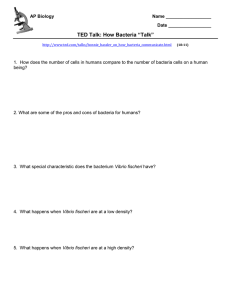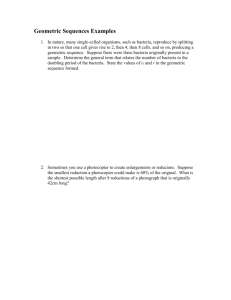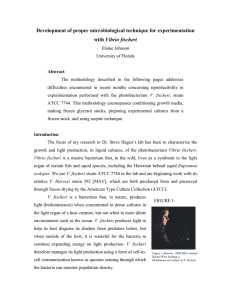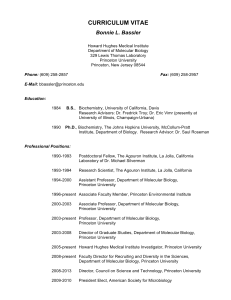QuorumSensing_TEDtalkVideoHandout_KEY
advertisement
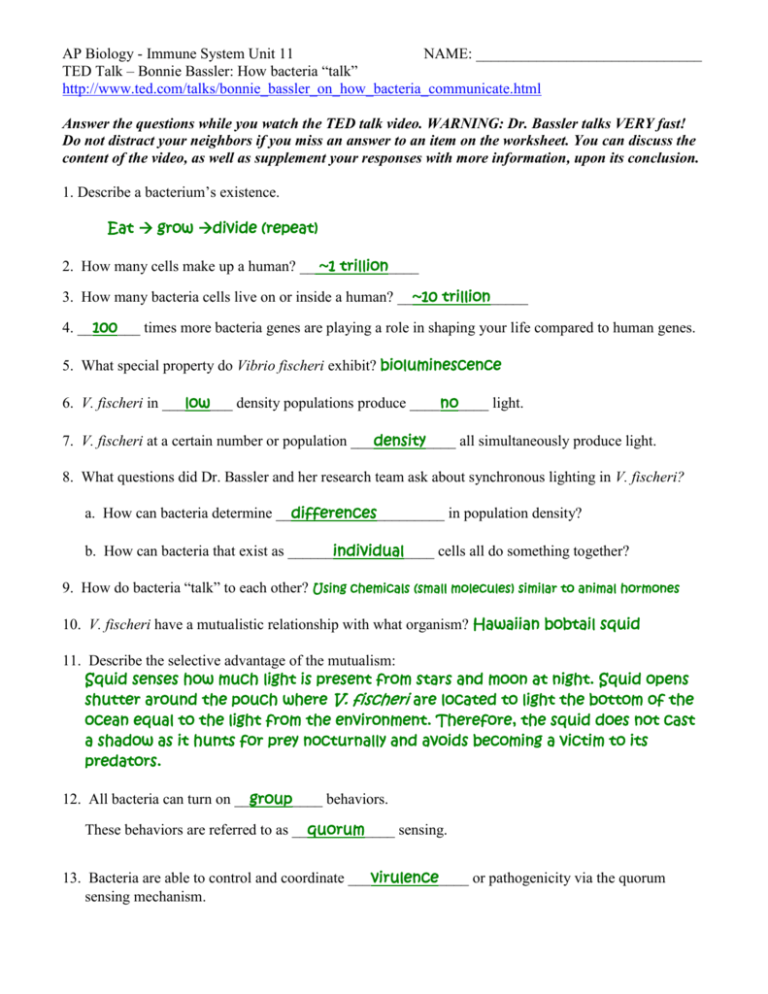
AP Biology - Immune System Unit 11 NAME: ______________________________ TED Talk – Bonnie Bassler: How bacteria “talk” http://www.ted.com/talks/bonnie_bassler_on_how_bacteria_communicate.html Answer the questions while you watch the TED talk video. WARNING: Dr. Bassler talks VERY fast! Do not distract your neighbors if you miss an answer to an item on the worksheet. You can discuss the content of the video, as well as supplement your responses with more information, upon its conclusion. 1. Describe a bacterium’s existence. Eat grow divide (repeat) 2. How many cells make up a human? __ ~1 trillion____ 3. How many bacteria cells live on or inside a human? __~10 trillion_____ 4. __100___ times more bacteria genes are playing a role in shaping your life compared to human genes. 5. What special property do Vibrio fischeri exhibit? bioluminescence 6. V. fischeri in ___low___ density populations produce ____no____ light. 7. V. fischeri at a certain number or population ___density____ all simultaneously produce light. 8. What questions did Dr. Bassler and her research team ask about synchronous lighting in V. fischeri? a. How can bacteria determine __differences_________ in population density? b. How can bacteria that exist as ______individual____ cells all do something together? 9. How do bacteria “talk” to each other? Using chemicals (small molecules) similar to animal hormones 10. V. fischeri have a mutualistic relationship with what organism? Hawaiian bobtail squid 11. Describe the selective advantage of the mutualism: Squid senses how much light is present from stars and moon at night. Squid opens shutter around the pouch where V. fischeri are located to light the bottom of the ocean equal to the light from the environment. Therefore, the squid does not cast a shadow as it hunts for prey nocturnally and avoids becoming a victim to its predators. 12. All bacteria can turn on __group____ behaviors. These behaviors are referred to as __quorum____ sensing. 13. Bacteria are able to control and coordinate ___virulence____ or pathogenicity via the quorum sensing mechanism. 14. Examination of quorum sensing molecule structure reveals that all bacteria species produce different_, private, unique molecules. The shape of the molecule in each species specifically fits the shape of that species membrane receptor thus facilitating __intra_-species communication. 15. However, most bacteria species live in larger, prokaryotic-dominated communities. Therefore, upon examination and research, a chemical used for _____ inter_-species communication was discovered. 16. In order to regulate bacterial growth and virulence, biologists have developed _ anti_-quorum sensing molecules that prevent either intraspecies or interspecies communication between cells. 17. SUMMARY: In addition to filling in the blanks, please feel free to write additional information under each bullet point. Bacteria __talk__ to each other. Communication between bacteria facilitates collective behaviors and promotes survival for all cells Bacteria behave as though they are ___multicellular_____. Bacteria probably paved the way for the development of multicellular, eukaryotic organisms such as humans. Human cells talk to each other to maintain diverse functions in a variety of body tissues and organs. Bacteria can distinguish __self____ from others. Bacteria can talk to other cells. Bacteria have a mechanism to allow them to sense and respond to changes in their environment in order to survive, reproduce, and evolve. Biologists have developed strategies to impede or improve bacteria’s __quorum sensing____ mechanisms for communication. Quorom sensing mechanisms should be promoted (and enhanced) for the species of bacteria that are the natural fauna existing on the human body. Quorom sensing mechanisms can become the new pharmaceutical weapon used in the war against highly virulent, multi-drug resistant strains of bacteria I agree with Dr. Bassler’s concluding statements about feeling privileged to work with young people who make tremendous academic discoveries and advancements. Keep asking questions and working smart! Continue being the engines that drive scientific discovery and providing explanations about our natural world! (And don’t forget to invite me to your Nobel Prize party! )
